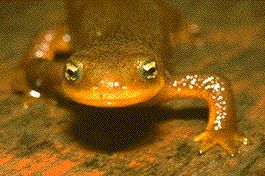The evidence for evolution - What evidence does the fossil record provide?

The fossil record suggests evolutionary relationships.
The main subgroups of vertebrates, on a conventional classification, are: fish, amphibians, reptiles, birds, mammals. It is possible to deduce that their order of evolution must have been fish then amphibia then reptiles then mammals; and not, for example, fish then mammals then reptiles then amphibia.
The deduction follows from the observation that an amphibian, such as a frog is intermediate in form between a fish and a mammal. Amphibians, such as the Californian newt pictured here, have gills, as fish do; but have four legs, like reptiles and mammals, and not fins. If fish had evolved into mammals, and then mammals had evolved into amphibians, the gills would have been lost in the evolution of mammals and then regained in the evolution of amphibia; which is much less likely than that amphibia evolved from fish, retaining their gills, and the gills were then lost in the origin of mammals.
The forms of modern vertebrates alone, therefore, enable us to deduce the order in which they evolved.
The inference, from the modern forms, can be tested against the fossil record. The fossil record supports it: fish, amphibians, reptiles, and mammals, appear in the fossil record in the same order as they should have evolved.
| Next |



